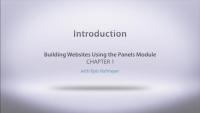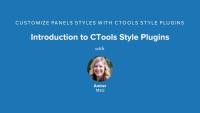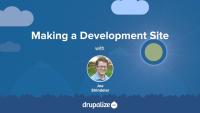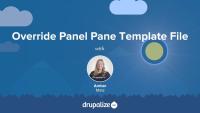Panels provides export code that you can copy and paste into a module or directly import into another instance of the site.
In this lesson, we will:
- Export a panels page using Panels UI
- Import a panels page into another instance of site
By the end of this lesson, you will understand where to find the export code for a panel and be able to simply and quickly import it into another copy of your site.
Demo site log in:
- Navigate to /user
- Login with admin/admin
In this first series of Panels videos on Drupalize.me you will learn how to use the Panels module to take your Drupal website to the next level. When you reach the limits of what Drupal alone allows you to do with its layouts, adding Panels to your site enables you to create more sophisticated displays of your content. Here are just a few things the Panels module makes easy:
- Divide the display of your content into multiple columns
- Place blocks into the center of your pages
- Use different layouts on the same page, under different circumstances
Because Panels works with the Page Manager module in ctools, you get all the benefits of the page manager, as well as complex control of your layouts. Page manager allows you to take over many of the ‘default’ displays in Drupal, including the display of content (nodes), profiles (users), category listings (taxonomy), and also the edit forms for each of these entities.
Additional resources
We'll use Page Manager, Panels, and Views to create a customized user account page that features articles authored by the user whose account is being viewed.
In this lesson...
- Build a view of articles with a contextual filter
- Create a customized user account page
By the end of this lesson, you'll walk away with ideas for how to create your own customized user account page.
Demo site log in:
- Navigate to /user
- Login with admin/admin
Additional resources
In this exercise you will demonstrate knowledge of Panels, and create a layout for the Top Ten List page, and create and configure content within Panel Panes.
In this tutorial, I'll walk you through how to add a CSS class or ID to a panel pane using the Panels administrative console.
Additional resources
Building Websites in Drupal 7 using Panels — Drupalize.Me
Chaos Tools Suite (CTools) — Drupal.org
Panels — Drupal.org
Today we're excited to roll out a new installment in our series on Building Websites in Drupal 7 with Panels. In the continuation of this series, I will be walking you through modules and functionality provided by Panels, CTools, Page Manager, Views and more.
Panelizer is a powerful module that allows you to attach panels to any entity and view mode in Drupal. You can create default templates for all content in a content type, for example, or you can create one-off pages with unique layouts and content panes.
In this lesson...
- Walk through Panelizer admin UI
- Panelize Article content
- Set up default Panelizer template
- Override versus Update Default Template
By the end of this lesson, you should be able to configure Panelizer settings, enable Panelizer for a content type, and understand the benefits and limitations of creating one-off pages that override the default template versus updating the default template.
Enabling the Panels In-Place Editor is recommended for this lesson.
Demo site log in:
- Navigate to /user
- Login with admin/admin
Additional resources
Today, we've got another batch of video tutorials to wrap up our series on Building Websites in Drupal with Panels. This week's lessons focus on other modules related to Panels such as Mini Panels, Panel Nodes, and Panelizer modules.
This week we are launching a great new series by Jen Lampton, "Building Websites Using the Panels Module," in addition to continuing our Coding for Views series. The Panels module which has been a long requested video series from our members and we are proud to kick that off with this introductory set of videos.
Jen covers everything from the Panels interface to using variants for multi-scenario layouts. She'll cover creating multi-column pages and how the Page Manager module, part of CTools, with Panels gives us a much more flexible layout engine than Drupal alone. This will lay a great foundation for a future, advanced series on how to use code with Panels to really get crazy.
New Video Tutorials
Drupalize.Me Podcast 2 with Jen Lampton
Blog post We're happy to present episode 2 of the Drupalize.Me podcast. In this podcast, Addi interviews Jen Lampton, who is a long-time Drupal contributor.
We're happy to present episode 2 of the Drupalize.Me podcast. In this podcast, Addi interviews Jen Lampton, who is a long-time Drupal contributor.
This week we keep rolling out handy modules that everyone should know about, with a look at two very popular modules for extending the Views module. The first, Entity Views Attachment (EVA), lets you attach any of your views to various entities on your site, like nodes or users. This is handy when you want to display a view as part of another entity on your site, instead of displaying it on its own URL.
Drupal 8.3 is still a few months away, coming April 5, 2017, but there are already some changes we can look at, most notably in the experimental modules. In December, 2 new experimental modules were added to core, and BigPipe was officially changed from a beta module to stable. The 2 new modules you’ll find in 8.3 are Workflows and Layout. Let’s take a peek at what these are all about.
Drupalize.Me Update, July 2015
Blog postIt's that time again! Here's an overview of what we've been working on recently at Drupalize.Me.
What's New at Drupalize.Me
Blog postIt’s that time again! Here’s an overview of our recent accomplishments and important updates.
We’ve been busy creating tutorials for you! Mostly we've been focusing on Drupal 8 module development, but we've also made updates to our Configuration Management and Drupal 8 Theming series. In addition, we have a fresh batch of Drupal 7 Hands-On Exercises using the Movie Project. Check out what we’ve published or updated in January and February of 2017.
A CTools Style Plugin allows a developer to provide a settings form and a template file that can be chosen and configured by a site administrator using the Panels "Style" interface.
In this lesson, we will:
- Explore Panels' Style Interface
- Identify Default Panels Styles
- Introduce Demo Style Plugin
By the end of this lesson, you will understand how to access Styles in Panels and why you might want to create your own custom Styles interface for your site's editors to use.
Additional resources
The code for this plugin and module is located in sites/all/modules/demo_panestyles. See Companion Files to download the Files export, which also contains a demo site for Lessons 8-19 of Building Websites in Drupal 7 with Panels. Log in at /user with username "admin" and password "admin."
How to make a copy of a live site for development purposes.
The panel pane template file controls the markup for the panel pane container. When you place content into a panel region, it is wrapped by a container called the panel pane. To change this wrapper markup, you will need to copy the panels pane template file into your theme’s templates directory. Let’s walk through this process in this tutorial.
Additional resources
Building Websites in Drupal 7 using Panels — Drupalize.Me
Chaos Tools Suite (CTools) — Drupal.org
Panels — Drupal.org
This tutorial looks at the steps that Drupal goes through to obtain a render array for an incoming HTTP request, transform the render array into HTML, and then return it to your browser. We provide an outline of the process and links to resources for more in-depth information. We also take a more thorough look at the HtmlRenderer which converts a render array into HTML. Knowing how the render arrays you write in your code are ultimately used can help you optimize Drupal's Render API to describe your module's content.







